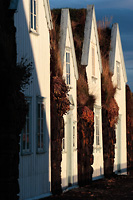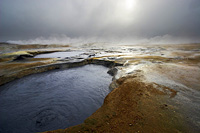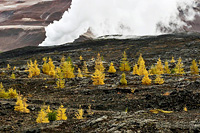
Iceland, October 2006
Iceland has truly some of the most spectacular and alien landscapes I have ever seen. From the barren wastelands of black lava flow,
covered by an unending carpet of wet green moss and stretching to the horizon where ancient sea cliffs stand proudly inland miles from the shore;
to deafening waterfalls, steaming volcanic fumeroles and boiling pools of mud, and the immensity of the glaciers... it holds limitless potential
for landscape photographers.

















Church, Snaefellsnes Peninsula
Iceland is dotted with many tiny remote churches - which in places seems to number almost as many as the houses - and this one at Budir
is no different, situated between a rocky coastline and the barren expanse of an ancient lava flow.
Svartifoss Waterfall, Skaftafell National Park
This waterfall is surrounded by the distinctive dark hexagonal lava columns which give rise to its name, "Black Falls." The geometric
shapes of the columns are produced by contractual fractures inside a slowly cooling lava flow - the Giant's Causeway is the UK's famous example.
Grenjađarstađur, North Iceland
Grenjađarstađur, North Iceland
Grenjađarstađur was once the manor of the county; the oldest part dates back to the early 19th century and in 1877 most of the
traditionally turf-covered houses were restored or renovated. But by 1932 the remaining inhabitants had left and the farm was abandoned,
eventually reopening as a district folk museum in 1958 which it still is today.
Hverarönd, North Iceland
This volcanic area of boiling pools, silvery mud and steaming fumeroles looks like a different planet. It felt like one too thanks to the
freezing gale force arctic conditions prevailing that day - the 4x4's heated seats were never more welcome!
Kisilidjan Diatomite Plant, North Iceland
Autumn pines litter a barren lava field which surrounds the chimneys of this industrial plant near the northern shores of Lake Mývatn.
Volcanic boiling mud pool, Hverarönd
These vile-smelling bluish-grey belching pools of mud dot the alien landscape of Hverarönd, a volcanic hotspot in North Iceland. They're
formed when groundwater percolates deep underground where it is heated by magma, forcing it to the surface to form hot pools.
Gullfoss
It's no coincidence that Iceland has an unusually high number of spectacular waterfalls. Its proximity to the Arctic, together with
the frequent rain and snow brought by its north Atlantic climate has produced immense glaciers which cover 11% of its surface. Their
summer melts feed powerful rivers which over millions of years have carved from the rock some of the most unique and beautiful
waterfalls anywhere in the world. Gullfoss is one of the most popular, with the river plunging down into a deep crevice; here it's
shot in the early morning, with sunlight catching the spray.
Lómagnúpur, South Iceland
At 767 metres high this ancient sea cliff is the tallest in Iceland. It looms some distance inshore, and marks the point where the
southern flat farmlands were once submerged by the Atlantic ocean.
Farm, North Iceland
Dettifoss
Selfoss
Farm Track, South Iceland
Icelandic House
October is Iceland's rainiest month, but blustery autumnal weather interspersed with sunshine makes great conditions for
photography. This solitary house guards a rough track to the farms on the far hills, and its windows were lit up by reflection
of the bright sky clearing behind me. The sunbeam only penetrated the gloom for a short minute.
North Iceland
Turf Farm Buildings, Núpsstađur
The old farm at Núpsstađur shelters under some dramatic cliffs, with turf-roofed buildings dating back as far as the early 19th century.

